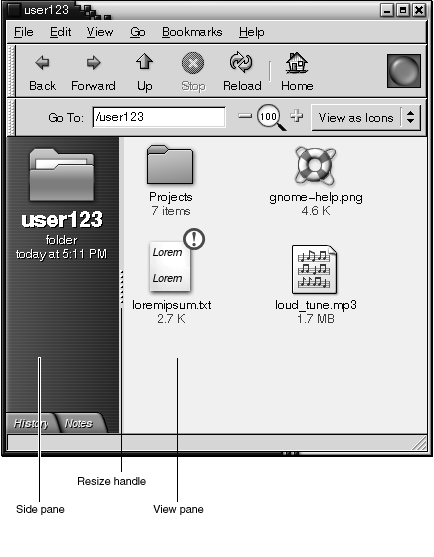Navigating Windows
The following sections describe the keyboard shortcuts that you can use to navigate windows. A window is a rectangular frame on your screen that displays an application.
Note –
You can customize all of the keyboard shortcuts that are associated with navigating windows. See Navigating Your Workspaces for more information.
To Give Focus to a Window
Before you can use or modify a window, you must give focus to the window. The following table lists the keyboard shortcuts that you can use to give focus to a window.
|
Keys |
Function |
|---|---|
|
Alt+ Tab |
Display a popup window with icons that represent each window. Press-and-hold Alt and continue to press Tab to move through the windows until you reach the window to which you want to give focus. |
|
Alt+Esc |
Raise each window in turn until you reach the window to which you want to give focus. |
To Control a Window
When a window has focus, you can perform various actions on the window. The following table lists the keyboard shortcuts that you can use to control the window that has focus.
|
Keys |
Function |
|---|---|
|
Alt+ spacebar |
Open the Window Menu. |
|
Alt+F4 |
Close the window. |
|
Alt+F9 |
Minimize the window. |
|
Alt+F10 |
Maximize the window. |
|
Alt+F5 |
Restore a maximized window to the original size of the window. |
To Move a Window
When a window has focus, you can move the window around the screen. The following table lists the keyboard shortcuts that you can use to move a window.
|
Keys |
Function |
|---|---|
|
Alt+F7 |
Start the move operation. |
|
arrow keys |
Move the window 10 pixels at a time in the direction of the arrow key. |
|
Ctrl+ arrow keys |
Move the window one pixel at a time in the direction of the arrow key. |
|
Shift + arrow keys |
Move the window in the direction of the arrow key to align it with the edge of the nearest window, panel, or screen edge. |
|
spacebar |
Complete the move operation and leave the window in the current position. |
|
Esc |
Cancel the move operation and restore the window to the original position. |
To Resize a Window
When a window has focus, you can increase or decrease the size of the window. The following table lists the keyboard shortcuts that you can use to resize the window that has focus.
|
Keys |
Function |
|---|---|
|
Alt+F8 |
Start the resize operation. |
|
arrow keys |
Resize the window in the direction of the arrow keys. |
|
spacebar |
Complete the resize operation and leave the window at the current size. |
|
Esc |
Cancel the resize operation and restore the window to the original size. |
To Navigate Paned Windows
A paned window is a window that is split into two or more panes. The
Help browser and the Nautilus file manager are
examples of applications that use paned windows.
Figure 3–1 Example of a Paned Window

The following table describes the keyboard shortcuts that you can use to navigate windows with panes.
|
Keys |
Function |
|---|---|
|
F6 |
Give focus to the next pane. The system gives focus to the control that last had focus in the pane. |
|
F8 |
Give focus to the first resize handle in the window. The resize handle is displayed between the panes and enables you to resize the panes. Press F8 again to give focus to the next resize handle. |
When the resize handle has focus, you can use the keyboard shortcuts that are listed in the following table to modify the paned window.
|
Keys |
Function |
|---|---|
|
arrow keys |
Move the resize handle by a small amount. |
|
Ctrl + arrow keys |
Move the resize handle by a large amount. |
|
Home |
Reduce the size of the pane to the left of the resize handle for vertical panes, or above the resize handle for horizontal panes, to the minimum size allowed. |
|
End |
Increase the size of the pane to the left of the resize handle for vertical panes, or above the resize handle for horizontal panes,to the maximum size allowed. |
|
spacebar |
Set the position of the resize handle and return the focus to the last control that had focus. |
|
Esc |
Reset the position of the resize handle to the original position and return the focus to the last control that had focus. |
- © 2010, Oracle Corporation and/or its affiliates
